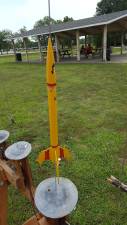| Construction Rating: | starstarstarstarstar_border |
| Flight Rating: | starstarstarstarstar |
| Overall Rating: | starstarstarstarstar_border |
| Published: | 2020-07-27 |
| Diameter: | 0.98 inches |
| Length: | 19.50 inches |
| Manufacturer: | Estes  |
| Skill Level: | 2 |
| Style: | Futuristic/Exotic |
 Brief
Brief
I'm always keeping an eye on eBay for out-of-production kits. About a year ago I spotted an Estes Starbird kit. It had been opened, which must have hurt interest as I was the only bidder. All parts were accounted for and I was happy for my good fortune. While essentially a 3FNC rocket, the three-section fins move it to the realm of the unusual. It's not an easy kit to find these days, but plans with fin templates are available on rocketshoppe.com.
Components
- BT-50L Body Tube - 12.7"
- BT-20 motor mount tube
- PNC-50Y nose cone
- Engine Hook
- 1/8" lunch lug
- 2 x CR2050 centering rings
- Engine block/thrust ring
- 1/8" dowel rod - 12" long
- 3/32" balsa fins
- 18" rubber band shock cord
- 12" parachute
- Waterslide decals
Construction
I always start with the motor mount. This is the standard 18mm motor mount you have built many times if you have built any Estes kits. The fins must be assembled prior to gluing them onto the body tube. A template is provided for building the fins. Each fin is three separate pieces. You have to cut three 4" sections of the 1/8" dowel rod. The dowel rod is then sandwiched between the inner and outer sections of each fin. The only con is the dowel rod is 1/32" thicker than the balsa sections of the fins. I placed some wax paper over the fin template and overlaid the fin pieces over the plan, gluing each balsa to the wooden dowel. This resulted in one side of the find being flat, while the dowel sticks up 1/32" on the other side. I didn't think it was worth the trouble to attempt centering the 3/32" fin sections on the 1/8" dowel. I think it worked out fine, as it's not really noticeable without looking closely. Once the fins are assembled, a fin marking guide can be used in conjunction with the proverbial door frame to make your fin mounting lines on the tube. I used Titebond II to tack on the fins and then added Titebond II filets.
The shock cord is the rubber band variety and uses the standard Estes Tri-fold mount. I tied on another 15" of elastic band to hopefully eliminate any chance of a zipper. Finally, I assembled the parachute. For some reason, putting together the parachute is one of my least favorite tasks of building a rocket. I did remember to glue the launch lug to the body tube prior to painting, something I've been known to forget. The plastic nose cone is two parts. I used plastic model cement to glue the shoulder into the nose cone.
I would put this at a level two build due to the multi-part fins, but really anyone with any build experience can handle this one. Finished, my Starbird weighed 1.67 ounces without a motor.
Pros: Usual Estes components. Clear instructions.
Cons: Rubber band shock cord. Dowel rod thicker than balsa fin sections
Finishing
Finish is pretty easy for this one, as the entire rocket is yellow. First I sealed the fins with GWF. My only issue with GWF is it makes a heck of a mess while you sand it.
I tend to use Rustoleum or Ace Hardware's in-house brand for the painting. I have a bad habit of going to heavy and having to sand off runs but I did a pretty good job on this one.
Despite the age of the kit, I found the waterslide decals were still in good condition laid down nicely. I then gave everything a clear coat. Despite the single-color paint scheme, the decals really pop and add a lot to the Sci-Fi appearance of the model.
Flight
I have flown this model twice. First time on a B4-4 and the second flight was a B6-4. Obviously a little quicker off the pad with the B6-4 but performance was excellent on both flights. Straight up and ejection, while nose-down, was just after apogee. I would guess they were somewhere in the range of 500'. Not sure if I will try this on a C motor. At an ounce and a half, a C may be out-of-sight.
Recovery
The 12" parachute gave a good descent rate, although I suspect you could get by with a 9" chute. So far I've had no issues with the rubber band shock cord, but just make sure to use plenty of wadding. I have not used a spill hole but would consider that if I ever go with a C motor. Still, neither retrieval walk was long on the two flights.
Summary
This is one excellent flying rocket. The three-section fins and attractive decals give it some eye appeal. It's not an easy kit to find, but with the plans and fin templates available online, building a clone is not a difficult project. All components are readily available. I've flown it in 10 MPH winds and it is just arrow straight.
 |
 |
Flights
Sponsored Ads
 |
 |











